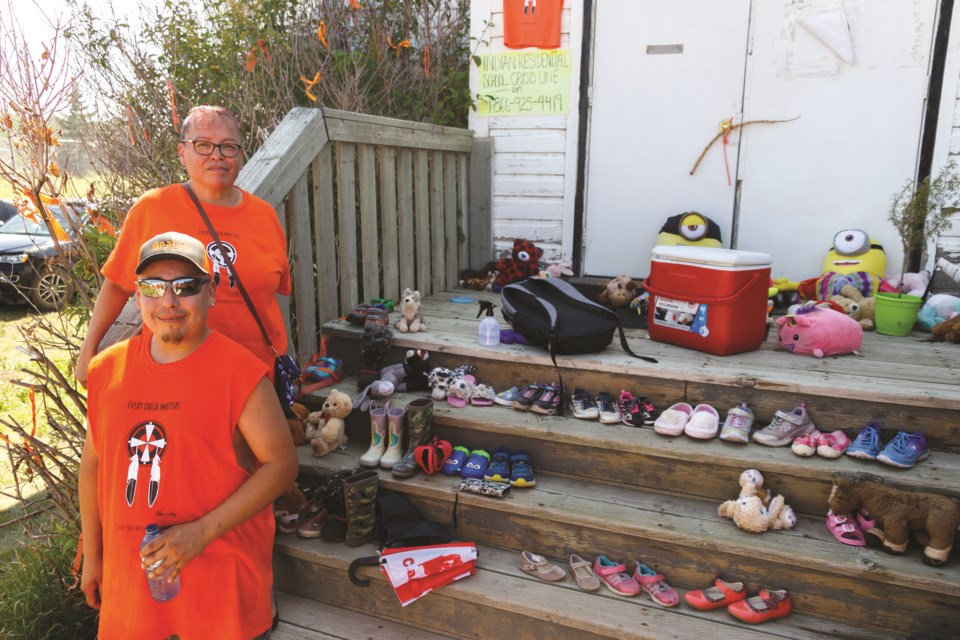STONEY NAKODA— Gathering together to commemorate and honour the recently discovered unmarked graves at former Canadian Residential Schools, a group of more than 50 people wearing orange shirts trekked in the blistering 39 C heat on Canada Day in Stoney Nakoda First Nation.
Walk co-organizer Eve Powder said the march was planned as a way to observe the children found in unmarked graves at former Residential Schools across the country and acknowledge the lingering trauma created by the Residential School system.
The walk in Stoney Nakoda wound three kilometres from the Chiniki Gas Station to the United Church at the Morley townsite.
“I didn’t really think about the heat … I focussed on finishing the walk so that I could show support,” Powder said. “We were all focussed on the children that were found.”
In June, 215 Indigenous children’s remains were located in unmarked graves at the former Kamloops Residential School in British Columbia, as many as 751 unmarked graves were discovered at the former Marieval Residential School in Saskatchewan and a total of 104 unmarked graves were located at the former Brandon Residential School in Manitoba.
Powder felt it was important to bring the walk in their honour to Stoney Nakoda First Nation to ensure the stories of Residential School victims are not lost.
“I want them to know that they’re not forgotten and that we always keep them in our hearts and we will support as much as we can. They will never be forgotten,” Powder said.
The event ended with a round dance in front of the Morley United Church to honour the memories of the children.
“It was to send healing out to all the families of the children that were found,” Powder said.
The event left Powder with a feeling of hope, she said, and she appreciates Indigenous and non-Indigenous allies who participated.
She is optimistic the event marks the start of people actively looking to learn about Indigenous culture, traditions and experiences. She added the walk seems to have struck a chord and many people have been reaching out to learn more.
“Non-Indigenous people need to realize that we are also human— We all bleed the same. Just our skin is different,” Powder said.
The unearthing of the mass graves has created a heavy conversation in the community and brings back bad memories for Residential School survivors. Powder said each discovery reignites traumas that have lasted generations.
She cautioned conversations surrounding Residential Schools need to be treated with care and called for prayers, smudge and support as survivors are forced to relive past traumas.
“From my point of view, it will not stop. It will keep continuing— Until our voices are heard,” Powder said.
Co-organizer Clement Holloway said he was compelled to bring the walk to Stoney Nakoda given the recent tragedies surrounding Residential Schools.
“It was for the support and acknowledgement of our Residential School survivors and to honour our ancestors who didn’t make it home,” Holloway said. “We’ve been silenced for too long.”
Holloway said the walk served as an opportunity to bring generations, community members and allies together.
“I’m hoping this is the beginning of many. My goal is to push this awareness and really try and push for change on our reserve,” Holloway said. “We had the support of our people which is the most important thing.”
While the discoveries of the unmarked graves have been traumatic, Holloway said, there is a sense of relief in knowing the voices of survivors and Indigenous communities are finally being heard, recognized and respected.
The traumatic impact of Residential Schools has been a challenging conversation in Canada, Holloway said, after years of this aspect of Canadian history largely being ignored.
The recent revelations of unmarked graves have created undeniable proof about the generation-spanning damage of Residential Schools.
“How could people do such a thing,” Holloway said.
Residential School survivors need to be heard as their experiences are part of an important and dark side of Canadian history.
His grandparents were Residential School survivors and his parents are part of the 60s scoop. These experiences have created intergenerational trauma in his family.
“It’s time to break that cycle,” Holloway said. “The whole country knows about it. There’s no hiding it anymore.”
While work still remains in terms of Reconciliation, Holloway said, the walk and conversations about the unmarked graves mark a stark change in the treatment of Indigenous people.
He is grateful unity is being found through sharing and boosting these stories, which in turn provides a sense of hope and belonging.
“This is our land … After our culture and everything that has been stripped from us, we can walk around with our heads up now,” Holloway said. “To feel equal is a good feeling.”
For Holloway one of the most powerful aspects of the walk was seeing the allies who showed up to show their support participating in the walk and round dance on Canada Day.
“The round dance at the end that was beautiful. I cannot remember when the last time we had a round dance was,” Holloway said. “We were dancing in a circle. It’s a unity dance. We all joined hands and danced together.”
Read more from CochraneToday.ca



